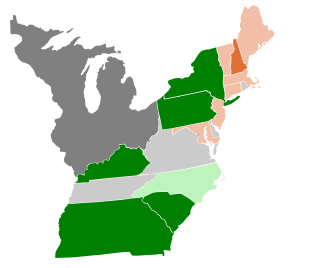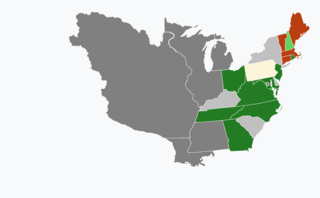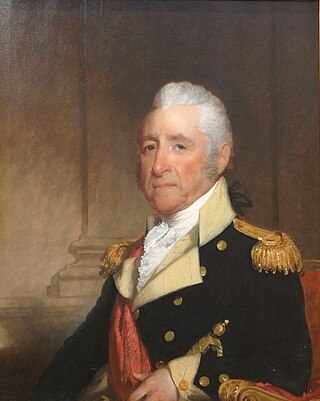
The 1802–03 United States Senate elections were elections for the United States Senate which resulted in the Democratic-Republican Party maintaining and greatly expanding their majority of seats to over two-thirds of the Senate.

The 1800–01 United States Senate elections were elections for the United States Senate that, coinciding with their election to the White House, also led to the Democratic-Republican Party taking control of the United States Senate. Although the Federalists began the next 7th Congress with a slim majority, they lost their majority shortly thereafter due to mid-year special elections.

The 1801 Rhode Island gubernatorial election was an uncontested election held on April 1, 1801 to elect the Governor of Rhode Island. Arthur Fenner, the incumbent Governor, was the sole candidate and so won with 100% of the vote.

United States gubernatorial elections were held in 1800, in 11 states, concurrent with the House, Senate elections and presidential election.

United States gubernatorial elections were held in 1801, in 13 states.

United States gubernatorial elections were held in 1803, in 12 states.

United States gubernatorial elections were held in 1804, in 13 states, concurrent with the House, Senate elections and presidential election.
United States gubernatorial elections were held in 1810, in 13 states, concurrent with the House and Senate elections.
United States gubernatorial elections were held in 1806, in 10 states, concurrent with the House and Senate elections.

United States gubernatorial elections were held in 1805, in 13 states.

The 1798 New Hampshire gubernatorial election took place on March 13, 1798. Incumbent Federalist Governor John Taylor Gilman won re-election to a fifth term, easily defeating various minor candidates.

The 1802 New Hampshire gubernatorial election took place on March 9, 1802. Incumbent Federalist Governor John Taylor Gilman won re-election to a ninth term, defeating Democratic-Republican candidate, former Governor and U.S. Senator John Langdon.

The 1800 Connecticut gubernatorial election took place on April 10, 1800. Incumbent Federalist Governor Jonathan Trumbull Jr. won re-election to a third full term, effectively unopposed.

The 1801 Connecticut gubernatorial election took place on April 9, 1801. Incumbent Federalist Governor Jonathan Trumbull Jr. won re-election to a fourth full term, defeating Democratic-Republican candidate Richard Law.

The 1802 Connecticut gubernatorial election took place on April 8, 1802. Incumbent Federalist Governor Jonathan Trumbull Jr. won re-election to a fifth full term, defeating Democratic-Republican candidate Ephraim Kirby.

The 1807 Connecticut gubernatorial election took place on April 9, 1807. Incumbent Federalist Governor Jonathan Trumbull Jr. won re-election to a tenth full term, defeating Democratic-Republican candidate William Hart in a re-match of the previous year's election.

The 1821 Massachusetts gubernatorial election was held on April 2, 1821.

The 1820 Massachusetts gubernatorial election was held on April 3, 1820.

The 1823 New Hampshire gubernatorial election was held on March 11, 1823.

The 1810 Connecticut gubernatorial election took place on April 9, 1810.













